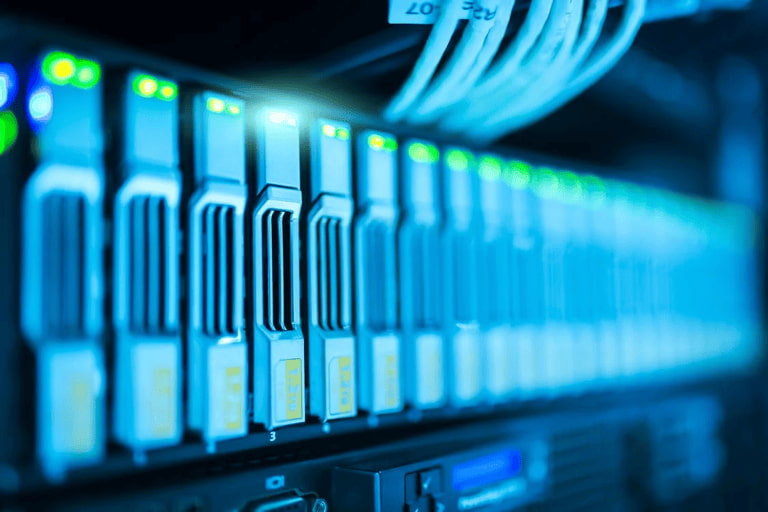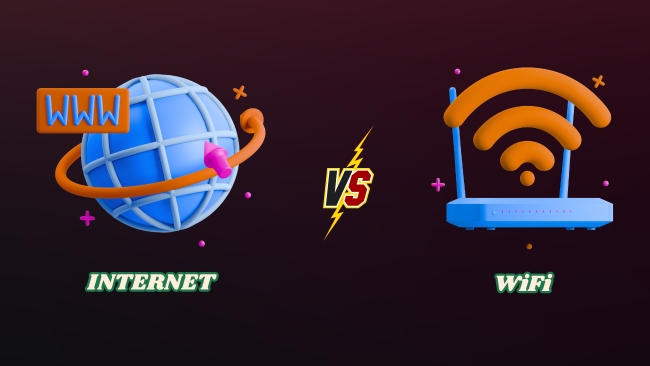In your household, it is easy to understand that when someone asks if the Wi-Fi is working, they are talking about whether you can access the Internet. However, there are many differences between the Internet and Wi-Fi. Knowing these differences will help you tackle networking issues easily while also minimizing potential confusion.
In this guide, I will explain the differences between the Internet and Wi-Fi, and I will start with an overview.
What is the Internet?
The Internet is a global network of connected devices. These devices communicate with each other using a set of globally approved protocols. These protocols make the Internet accessible from any part of the world as long as you have a compatible device, such as a computer, smartphone, etc.

The Internet is currently home to many applications and services, including the World Wide Web, file sharing, electronic mail, e-telephony, live streaming, etc. The possibilities of its use are ever-increasing, as is the social impact the Internet has had.
The Internet is powered by a global infrastructure that uses fiber-optic cables to connect different continents for data transfer. It also requires a set of devices such as a modem, router, switches, etc. The Internet can work in a wired format in that it does not rely on wireless signals for core functionality.
What is Wi-Fi?
Wi-Fi, on the other hand, is a wireless networking technology used for residential and commercial needs. It allows compatible devices to connect and transfer data using radio signals. These days, most devices, including smartphones, computers, printers, etc., work with Wi-Fi.

Though Wi-Fi is used for various purposes, it is most popular as a way to create a Local Area Network. You’d have one of these networks in your home, and you need a Wi-Fi router to manage the network. During the first stages, Wi-Fi had minimal speeds, but it can offer multi-Gigabit speeds these days.
The local area network created using Wi-Fi is often connected to the Internet. This way, devices on the Wi-Fi network will have access to the Internet as well. Because Wi-Fi is used the most for this purpose, it leads to situations where the terms Wi-Fi and the Internet are used interchangeably.
What is Broadband?
In the context of the Internet and connectivity, broadband is a type of connection that allows the transfer of a large amount of data within a shorter period. When you get a broadband Internet connection, you should expect better bandwidth and speed than a non-broadband connection like DSL or dial-up.
Broadband connection is also noted for other features like support for versatile applications, higher speed, and an always-on connection. Depending on the region and availability, broadband connections might use fiber-optic cables, coaxial cables, radio signals, or satellites for data transmission.
Considering the bandwidth requirements for the broadband label, most Wi-Fi networks these days are built for broadband connectivity. It means you can expect impressive speeds and transfer capabilities when you set up an Internet connection using Wi-Fi.
WiFi vs. Internet
Now that you know what Wi-Fi and the Internet are, we shall compare these two things. I have made a table that will help you spot the core differences.
Feature | Internet | WiFi |
Scope | Global network | Local wireless network |
Connection | Wired or wireless | Always wireless |
Purpose | Worldwide communication & data access | Wireless access to local/Internet network |
Equipment | Modem, router, cables | WiFi router/access point, WiFi devices |
Dependency | Independent of WiFi | Needs Internet for web access |
Range | Unlimited (infrastructure-based) | Limited (typically 50–100 meters) |
Protocols | TCP/IP, HTTP, etc. | IEEE 802.11 (WiFi standards) |
Security | Online threats (viruses, phishing) | Hacking, weak encryption risks |
Scope and Existence
The most significant difference between Wi-Fi and the Internet is in their scope. While the Internet is a global network, Wi-Fi has a more local scope. Wi-Fi does not require a connection to another network to exist. On the other hand, the Internet cannot exist without its interconnectedness. For reference, you can create a Wi-Fi network using a Wi-Fi router and a power outlet.
Connection Type
The type of connection used by Wi-Fi and the Internet is also different. The Internet can be accessed via both wired and wireless connections, such as fiber-optic cables or cellular signals. On the other hand, Wi-Fi always stays wireless as it relies on radio signals. In most cases, the Internet is delivered through fiber/coaxial cables, and Wi-Fi is used at a later stage to make it accessible wirelessly.
Purpose
As I mentioned earlier, the Internet and Wi-Fi serve different purposes. Whereas the Internet functions as a backbone for worldwide communication and data access, Wi-Fi is made for networking. It is primarily used to create a local area network without using cables. In addition, it can be used for file transfer between Wi-Fi devices as well.
Range
Because they are made for different needs, the Internet and Wi-Fi have varying support for range. In theory, the Internet has an unlimited range because it depends on infrastructure availability. Wi-Fi, on the other hand, has a limited range of about 50m to 100m. Though there are advanced Wi-Fi versions with additional range, they are not yet available to the mainstream.
Protocols
Though both the Internet and Wi-Fi need protocols, they use different ones. For instance, the Internet uses a variety of protocols like TCP/IP, HTTP, etc. They are integral for connecting to the Internet and getting data transferred between devices. On the other hand, Wi-Fi is powered by a number of protocols that the Wi-Fi Alliance decides.
Security
Because it does not have a central hierarchy, the Internet itself may not be subject to security issues. However, using the Internet may expose users to threats like malware and phishing. Wi-Fi, on the other hand, is prone to threats like hacking and spoofing. Most of these attacks work by gaining unauthorized access to your Wi-Fi network.
Wrapping Up
I hope this quick guide helped you understand the core difference between Wi-Fi and the Internet. Trust me, knowing the difference can help you communicate better while diagnosing issues or explaining what is wrong with the connection.



Leave a comment
Have something to say about this article? Add your comment and start the discussion.